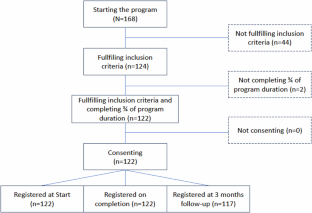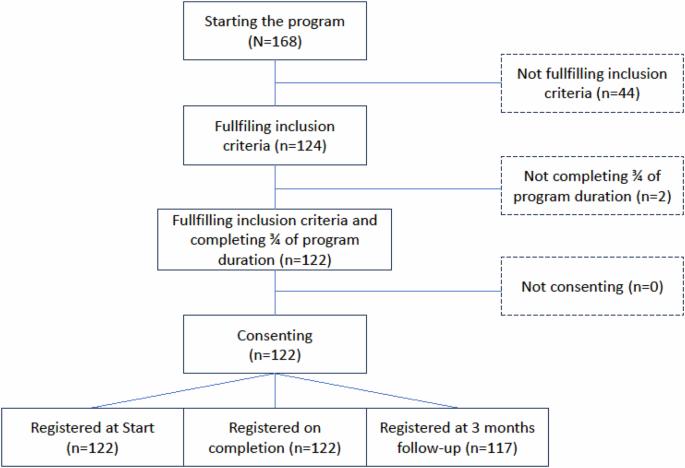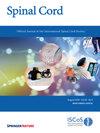波兰脊髓损伤患者在同伴引导的积极康复营期间接受轮椅技能培训的效果:一项队列研究
IF 2.2
4区 医学
Q3 CLINICAL NEUROLOGY
引用次数: 0
摘要
研究设计前瞻性队列研究。目的评估波兰脊髓损伤(SCI)患者在同伴引导的积极康复训练营(ARC)中接受轮椅技能训练(WSTR)的效果。我们假设参加 ARC 将提高 SCI 患者的轮椅技能表现和自我效能。我们还旨在确定与轮椅技能表现和自我效能提高更多相关的人口统计学和损伤相关因素。方法在 ARC 开始(T1)和结束(T2)以及 3 个月随访(T3)时,通过昆士兰轮椅技能评估 (QEWS) 和轮椅技能测试问卷 (WST-Q) 对 16 岁以上患有创伤性或非创伤性 SCI 的参与者(n = 122)进行评估。结果在 T2 阶段,43% 的参与者在 QEWS、73% 的 WST-Q 能力和 67% 的自信心方面分别达到了有临床意义的实质性改变的临界值,其中约有一半的参与者在 T3 阶段报告取得了此类进展。在小组层面上,参与者在第二阶段的QEWS方面取得了较小的效果;在第二阶段和第三阶段的轮椅技能能力方面取得了较大的效果;在第二阶段的轮椅技能信心方面取得了较大的效果,而在第三阶段则取得了较小的效果。参加 ARC 之前是唯一一个可以解释轮椅能力提高 10% 差异的自变量。这些改善在三个月后基本得以保持。SCI 患者应该有机会参加一次以上的训练营,以保持并进一步提高他们的轮椅技能。本文章由计算机程序翻译,如有差异,请以英文原文为准。


Effects of wheelchair skills training during peer-led Active Rehabilitation Camps for people with spinal cord injury in Poland: a cohort study
Prospective cohort study. To evaluate the effects of wheelchair skills training (WSTR) for participants with spinal cord injury (SCI) during peer-led Active Rehabilitation Camps (ARC) in Poland. We hypothesized that participation in ARC will improve wheelchair skill performance and self-efficacy in individuals with SCI. We also aimed to determine demographic and injury-related factors associated with greater improvements in wheelchair skill performance and self-efficacy. Thirteen consecutive ARCs in Poland. Participants (n = 122) with traumatic or nontraumatic SCI older than 16 years were evaluated at the beginning (T1) and completion (T2) of ARC and at 3-month follow-up (T3) through the Queensland Evaluation of Wheelchair Skills (QEWS) and the Wheelchair Skills Test Questionnaire (WST-Q). At T2, 43% of participants reached the threshold for substantial clinically meaningful change in QEWS, 73% in WST-Q capacity, and 67% in confidence, with approximately half of those reporting such gains at T3. At a group level, participants achieved small effect-size improvements (QEWS) at T2; large effects in wheelchair skills capacity at T2 and T3; large effects in wheelchair skill confidence at T2, and low effects at T3. Prior attendance to ARC was the only independent variable that explained 10% of variance in wheelchair capacity gains. Peer-led WSTR during ARCs is highly effective at improving wheelchair skills in individuals with SCI. These improvements are largely retained after three months. Persons with SCI should have a chance to participate in more than one camp to maintain and further improve their wheelchair skills.
求助全文
通过发布文献求助,成功后即可免费获取论文全文。
去求助
来源期刊

Spinal cord
医学-临床神经学
CiteScore
4.50
自引率
9.10%
发文量
142
审稿时长
2 months
期刊介绍:
Spinal Cord is a specialised, international journal that has been publishing spinal cord related manuscripts since 1963. It appears monthly, online and in print, and accepts contributions on spinal cord anatomy, physiology, management of injury and disease, and the quality of life and life circumstances of people with a spinal cord injury. Spinal Cord is multi-disciplinary and publishes contributions across the entire spectrum of research ranging from basic science to applied clinical research. It focuses on high quality original research, systematic reviews and narrative reviews.
Spinal Cord''s sister journal Spinal Cord Series and Cases: Clinical Management in Spinal Cord Disorders publishes high quality case reports, small case series, pilot and retrospective studies perspectives, Pulse survey articles, Point-couterpoint articles, correspondences and book reviews. It specialises in material that addresses all aspects of life for persons with spinal cord injuries or disorders. For more information, please see the aims and scope of Spinal Cord Series and Cases.
 求助内容:
求助内容: 应助结果提醒方式:
应助结果提醒方式:


